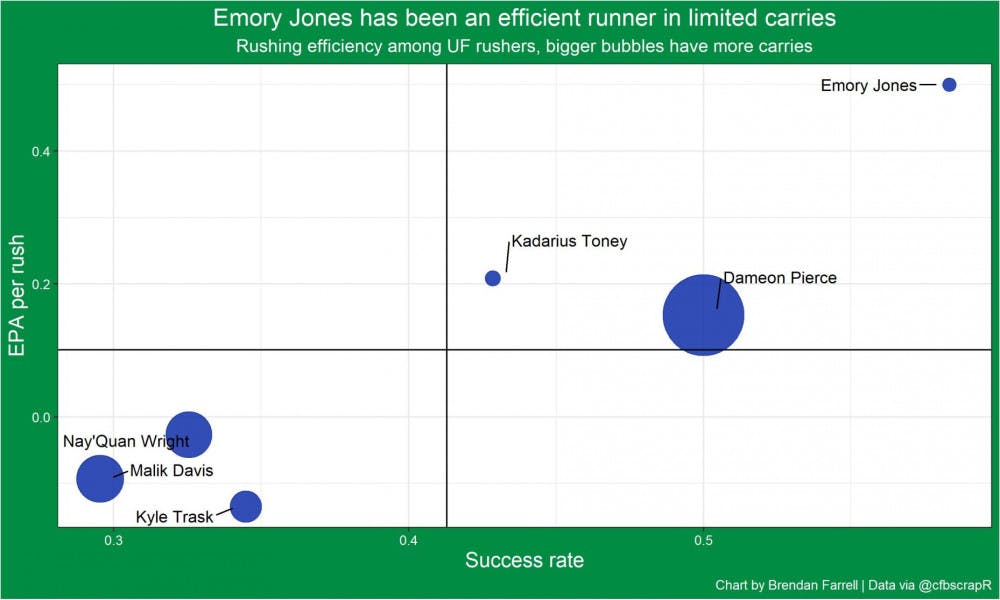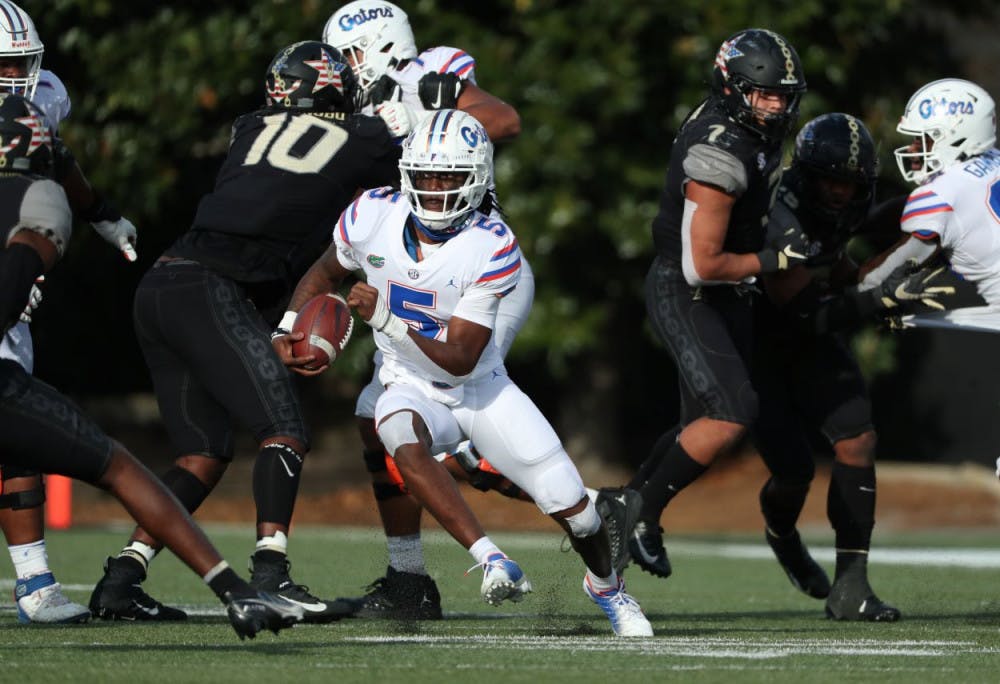When Emory Jones signed with the Gators in Dan Mullen’s inaugural 2018 class, he was seen as the starter in the wings with Feleipe Franks under center. Standing at 6-foot-2 with enticing passing abilities, Jones is a prototypical Dan Mullen quarterback.
Three years into the Mullen era, however, Jones still isn’t “the guy.” The Gators have instead turned Kyle Trask into a Heisman Trophy favorite.
For the last two years, Mullen has used Jones sparingly to spice up the offense and throw different looks at opposing defenses.
Jones had his moment on Saturday in the fourth quarter against Vanderbilt. On his fifth play of the game, Jones found tight end Kemore Gamble, who scampered to the end zone for a 30-yard score to seal a 38-17 win for Florida.
“It was pretty much the dagger,” Trask said. “He made the right read, and Kemore did the rest as far as execution goes.”
Does Jones make a difference with the offense?
Methodology
We’re specifically looking for when Jones entered a competitive game, not when he is playing in garbage time to relieve Trask. Garbage time is defined as a lead more than:
-
38 points in the second quarter
-
28 points in the third quarter
-
22 points in the fourth quarter
After ruling out all of Jones’ garbage-time snaps, we’re left with 22 snaps, which is a ridiculously small sample size. Consider this a warning.
When does Florida use Emory Jones?
Jones had a season-high eight snaps in the Gators’ season opener against Ole Miss.
The redshirt sophomore entered the game on Florida’s second drive in Oxford and promptly threw an interception. Mullen kept him on the field for the first two plays of the next drive and put Trask back in after Jones picked up a first down on a seven-yard run. In the third quarter, Jones led a five-play drive that resulted in a field goal to put the Gators up 41-21.
“We wanted to make sure that we got him in and let him play,” offensive coordinator Brian Johnson said. “Obviously, the first play design didn’t go as we’d planned. But he did a nice job, it didn’t faze him, he didn’t freak out at all.”
Jones didn’t make another appearance in a competitive game until he had three snaps against Georgia and another three against Arkansas as well. Jones’ usage ramped up against Vanderbilt with eight plays, though three came when Florida was running down the clock on the game’s final drive up 21 points.
He has been featured on 10 drives through seven games. Jones has had three one-and-done drives, but he’s performed better when given multiple plays. The first play of a Jones appearance has averaged 6.3 yards while later plays average 8.4.
How does Florida use Emory Jones?
It’s not a surprise, but Jones has been primarily used as a runner this season. Of his 22 snaps, 17 were running plays with Jones carrying the ball on 12 of them.
On those 12 plays, he has rushed for 64 yards (7.4 yards per carry) and a touchdown. Seven carries were “successful”, giving him a success rate of 58.3%, well above the Gators’ 41% on the season. Jones has also handed the ball off five times for 19 yards.
Again, small sample size, but Jones is the Gators’ most efficient rusher out of any player with at least 12 carries. Looking at Expected Points Added (EPA), which values plays as points, Jones’ eight carries averaged an EPA of 0.50 per carry, which is by far the best on the Gators.

“I think one thing Emory does in coming up, like changing the running back, that he brings a little different perspective to the position,” Mullen said. “When he is in there, (the quarterback run) does draw up very, very nicely, and the personnel fits him nicely as well.”
The Gators are averaging 3.7 points per drive when Jones makes an appearance and 3.49 points when he does not.
The use of Jones as a rusher has had a positive effect on Florida’s offense in some aspects, but there are still downsides.
Jones has been a mixed bag as a passer, but it’s hard to judge considering he’s only thrown five passes in competitive games. He’s 3 for 5 through the air for 56 yards, a touchdown and an interception.
The interception against Ole Miss is still one of the worst plays of the season for Florida, carrying the sixth-worst EPA value of any play for the Gators’ offense (-3.73). The Gators’ EPA per play with Jones in the game is just 0.07, a stark contrast to UF’s usual 0.27.
For the most part, Florida has avoided using Jones in obvious passing situations, with one exception. On the five-play drive against Ole Miss, running back Nay’Quan Wright was dropped for a loss of a yard, then Jones ran for five yards to set up a 3rd and 6 deep in Ole Miss territory. Mullen stuck with Jones, who threw an incompletion, forcing UF to settle for a field goal.
It was a weird decision considering that the Gators’ offense was rolling through Ole Miss’ defense like a hot knife through butter. It’s worth noting that Jones hasn’t appeared on third down since then.
What does all of this mean?
Florida’s run game could use the help that Jones provides. UF’s rushing performances have been mediocre at best this season.
It’s hard to fault Mullen for utilizing Jones as essentially another running back when the team is 47th in EPA per rush and 48th in rushing success rate. The Gators have only produced four running plays of at least 20 yards all season, and Jones has one of them.
Jones’ usage makes sense considering that it’s usually in favorable situations. When you have a quarterback that’s lighting the college football world on fire, it doesn’t make sense to keep Jones in for obvious passing downs.
“I think when you’re utilizing personnel in different ways, it certainly puts and adds pressure to the defense of how they’re going to match up against those different people,” Mullen said. “Schematically, there’s things Emory can do better than Kyle, so all of a sudden those things come into play schematically they have to prepare for, because you’re putting somebody in a position where they can do well.”
Contact Brendan Farrell at bfarrell@alligator.org and follow him on Twitter @Bfarrell727.
Gators backup quarterback Emory Jones zig zags between Vanderbilt defenders in Nashville, Tennessee, on Nov. 21. Jones threw Florida’s final touchdown pass in their 38-17 win over the Commodores Saturday.






